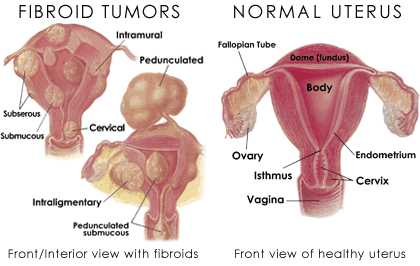
Myomectomy
Surgical treatment for fibroids
WHAT ARE FIBROIDS?
Fibroids are benign solid tumors of the uterus. Other names given to fibroids are myomas, leiomyomas, and fibromas. They represent the most common pelvic tumor found in women. Roughly, 20% of women over the age of 30 and in nearly 40% of women after the age of 40 have fibroid tumors.

They can range in size from microscopic to as much as 25 – 50 pounds and may be solitary but are most often multiple. The largest ever recorded weighed 140 pounds!
WHAT SYMPTOMS DO THEY PRODUCE?
Fibroids are usually discovered when they cause symptoms, although many women are asymptomatic when they are diagnosed on routine physical examination. Some women with fibroids experience changes in menstrual patterns. These changes may include heavier bleeding, often with clotting, or periods lasting longer than 7 days, or bleeding between periods. Anemia is a common finding among women with heavy periods related to fibroids, and as a result, they may feel easily fatigued. Pain and pressure in the pelvis are also common complaints among fibroid sufferers, as the enlarging uterus puts pressure on surrounding structures including the bladder (frequent urination similar to early pregnancy) and rectum (constipation and continuous rectal pressure). Pain with intercourse is also common.
CONSERVATIVE SURGICAL THERAPY FOR FIBROIDS
If you are reading this section it is probable because you are considering treatment for symptomatic fibroids. If so, read on. I will describe basic information about the procedure. Since the information here is basic and brief, you should schedule an appointment to discuss in depth whether you should consider this procedure or maybe a less invasive alternative.
Myomectomy is a procedure that surgically removes fibroids while leaving the uterus behind. The reason for leaving the uterus behind and taking out only the fibroids is to retain the capacity for fertility. To be very clear, the medical indication for myomectomy is fertility conservation in the face of complicating fibroids. The other reason for myomectomy is for the patient who wants treatment for fibroids but wants to retain the uterus, even though fertility is not desired.
MYOMECTOMY CAN BE ACCOMPLISHED IN TWO WAYS
A history of the previously mentioned symptoms will tip us off to the possibility of fibroids. Next, a physical exam may or may not reveal fibroids (some are located deep within the uterus and are therefore difficult to feel). Nevertheless, if symptoms are significant, an ultrasound examination should be done, searching for the etiology. Generally, an office ultrasound will show fibroids clearly. If they are located in the center of the uterus, then office saline hysterosonography will assess whether or not the fibroids may be removed in a conservative fashion.
Abdominal Myomectomy refers to the fibroid removal procedure performed through a large abdominal incision, either made vertically in the abdomen or in a transverse fashion (like a cesarean section incision). The size of the uterus would dictate the orientation of the incision.
Laparoscopic Myomectomy refers to a minimally invasive procedure to remove fibroids. Utilizing 4 small centimeter-long incisions in the abdomen, solitary or very few small, moderate, or large fibroids can be removed. The advantage of this procedure over the abdominal myomectomy procedure is quicker recovery. There are limitations to what sized or number of fibroids that can be safely removed in this manner, and careful mapping of fibroid location should be performed prior to entertaining this approach.
For large or multiple fibroids, or those located in a challenging location, especially in women who have no children and are trying to conceive, the abdominal approach is favored. This conservative approach is in my opinion, the best for many women. Just because you can remove fibroids laparoscopically doesn’t mean you should. In women who have children or who have solitary or very few fibroids that would be easy to remove with excellent repair of the uterus, the laparoscopic approach is the preferred method. The procedure may take longer than the abdominal approach, but the recovery can be as short as a few days.
THE ABDOMINAL MYOMECTOMY PROCEDURE
As mentioned previously, the abdomen is entered through a cesarean or “bikini-cut” incision. Rarely, size of the fibroids may dictate a midline or vertical incision on the abdomen. Once inside the abdomen, the uterus is injected with a medication that constricts blood vessels. This reduces surgical blood loss, something quite common with myomectomy procedures.
An incision is then made over the fibroid, which is then shelled out and removed. Think of making a cut in an avocado, scooping out the seed, then sewing up the avocado. Once all of the fibroids are shelled out, we sew up the defects in the uterus in multiple layers using dissolvable suture. Once all of the fibroids have been removed, the procedure is completed. The abdomen is closed and the patient transferred to the recovery room.
AFTER THE PROCEDURE
After a few days in the hospital, recovery continues at home. Usually after a week, most patients are able to get around okay, although pain medications are utilized for several weeks. Full recovery usually takes 4-6 weeks. The recovery of this type of procedure is much like that of an abdominal hysterectomy or cesarean section.
THE LAPAROSCOPIC MYOMECTOMY PROCEDURE
With an instrument called the laparoscope, a small incision is made in the umbilicus and a camera is placed through this incision. Then two or three smaller incisions are placed in the lower abdomen so that instruments can be used to perform the myomectomy. Once the fibroids are identified and the decision to proceed with the laparoscopic approach is made, the uterus is injected with a medication that contricts blood vessels. This reduces surgical blood loss, something quite common with myomectomy procedures. In the same manner as with the abdominal approach, an incision is then made over the fibroid, which is then shelled out and removed.
Think of making a cut in an avocado, scooping out the seed, then sewing up the avocado. Once all of the fibroids are shelled out, we sew up the defects in the uterus in multiple layers using dissolvable suture. The fibroid or fibroids are then removed from the abdomen by using a device called a morcellator. This instrument removes fibroids of any size by cutting them into strips of tissue that are easily removed through a small ¾ inch incision. Fibroid tissue is always sent for histologic confirmation to assure the benign nature of the tumors. The procedure generally takes from one (1) to three (3) hours, depending on the difficulty involved.
AFTER THE PROCEDURE
Following the laparoscopic myomectmoy procedure, my patients are ready and able to be discharged from the hospital the same or the following day. Rarely, patients may require a two-day stay in the hospital following surgery. The recovery after hospitalization is variable, but certainly much quicker than the abdominal approach for myomectomy.
Usually, full recovery takes 7 – 14 days. This is much different from the usual 6 weeks for abdominal myomectomy. Most of my patients are able to get around normally without strenuous activity in 3 – 4 days. I do, however, encourage them to rest for longer. I find the most irritating side effect of surgery to be fatigue. I always share with my patients that this type of surgery is deceiving. Even though there are only 3 – 4 small incisions, it still is major abdominal surgery! To some degree, the body undergoes something like a marathon while asleep under anesthesia. For that reason, it takes weeks to recover from basic fatigue. Even though physically my patients feel fine, they do complain of feeling tired. The treatment for this is, of course, rest and sleep.
RISKS ASSOCIATED WITH THE MYOMECTOMY PROCEDURES
As with any surgical procedure there are risks and there may be unforeseen complications (just as it is possible to have an adverse event when driving around town). Most patients go through surgery with little difficulty, but problems can occur ranging from trivial to fatal. We try to keep these risks in perspective, as they are indeed uncommon. The more common complications seen in the postoperative period include nausea, vomiting, pain, infection, poor healing, or formation of adhesions (scar tissue in the abdomen). Unexpected reactions may occur from any drug or anesthetic given. Unintended intra-operative injuries may occur to other pelvic or abdominal structures, such as fallopian tubes, ovaries, bladder, ureter (tube carrying urine from the kidney to bladder), or bowel. Such injuries are extremely rare and may require immediate or later additional surgery to correct the problem. Dangerous blood clots may form in the legs or lungs (a rare event since the advent of anti-thromboembolic compression stockings that are used routinely during surgery). Finally, it should be understood that it is impossible to list every possible undesirable effect, and that the condition for which surgery is done is not always cured or significantly improved and in rare cases, may even be made worse. This is a general description of risks associated with just about any surgical procedure, so please don’t think I list them because they are common.
OTHER OPTIONS TO CONSIDER
Although I feel strongly the myomectomy procedure should be done if possible in a minimally invasive fashion, I would still urge women to consider other options if possible. I am happy to explore these options with you. I recommend for my patients what I would recommend for my wife, sister, or mother. There are other alternatives that may be associated with less risk and may accomplish the same goal. For example, Office Endometrial Ablation may be successful in decreasing menstrual bleeding if heavy or prolonged menstrual flow is an issue in the presence of fibroids, and fertility is not desired.
Robotic Myomectomy
Click on any image to read the review ⤸
or click here to read additional procedures.
Patient Experiences on Procedures
We asked our patients for true and candid reviews on their overall experience with their decision-making process, understanding of the procedure, and outcome of results. Click on any of the following links to read.

